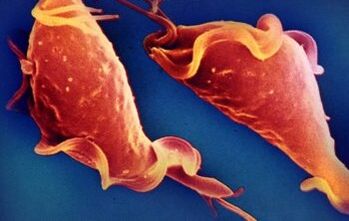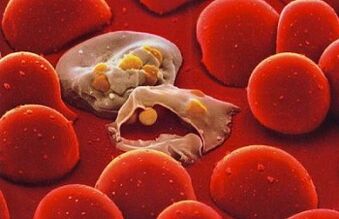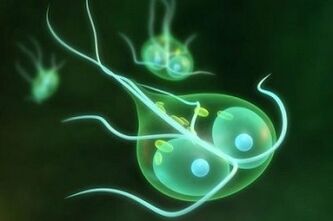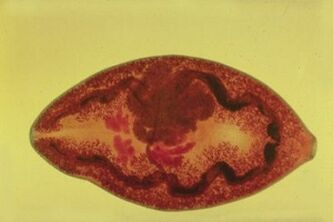Parasites often interfere with a person's normal life because they weaken the body. The article will explain how the representatives are most parasitic on us and how to deal with them.
Parasites are creatures that live and feed on their hosts. They can live in all animals, fish, birds and humans. This causes many problems, because these creatures are very harmful to health. Parasites in the human body can live in the liver, intestines, blood, and even attack the brain and lungs. What are the most common types? There are several different categories of parasites: flatworms and roundworms, protozoa, and insects. How they affect the body and how to get rid of them - will be explained in the article.
Types of parasites

As already mentioned, there are different types of parasites in the human body:
- protozoa (trypanosomes, malaria plasmodium, lamblia, dysentery amoeba);
- flatworms (catfish, liverwort, beef and pork tapeworm);
- roundworms (roundworm, pinworm);
- insects (lice, gadfly, fleas);
- chelicerae (ticks).
These species attack the human body the most. All of them are united by the fact that they are fed by the host's juices and tissues, and slowly killed. It is difficult to expel any of them, because each of them has many fastening devices (pacifiers, hooks, helisers) and some are even placed in the cells of the body, from which it is impossible to remove them.
Probably everyone knows about lice, fleas and ticks, because these creatures live on the surface of the body, they are easy to find and a little easier to fight. However, not everyone is aware of the internal parasites of the body, and in fact they are the most dangerous to health.
The simplest
These small organisms are found everywhere:
- in water;
- place;
- weather.
It is impossible to see them because they consist of only one cell. There are harmless representatives: ciliated shoes, proteus amoeba, green euglena and others. Some even help animals, for example, some ciliates digest cellulose from grass for cows, but there are many parasites among this abundance.
Plasmodia of malaria

Today, this Central African citizen persecutes many countries. Plasmodium malaria is carried by non-selective Anofel mosquitoes, and the basis for them is heat and water. Many countries have taken steps to prevent the disease: swamps have dried up, larvae have been destroyed, and the disease has receded there, but the parasite is still present in parts of Central Africa and South America.
Once in the body, malaria plasmodium goes through two stages: liver and erythrocyte. The first passes in a few hours. Plasmodium attacks liver cells, enters them, begins to multiply, and feeds on the host's food. At this point, a person already feels the first unpleasant symptoms:
- Headache;
- nausea;
- anorexia.
After a few days, the parasite enters the liver and enters the red blood cells. He has lived there for a long time. Every 3-4 days he leaves one and enters the other. The discharge is accompanied by the release of protozoan waste products, so the owner's temperature rises rapidly and strongly, fever, vomiting and intestinal diseases begin.
Plasmodium malaria is difficult to treat because the parasite is hidden in the host's cells. When the main symptoms of the disease appear, it is necessary to call an ambulance and water the patient regularly before arrival, because the temperature and fever cause dehydration. A type of plasmodium (more than 5 of them) will be installed in the hospital and treatment will be prescribed.
Prevention is very simple - if there is a ground for growing Anopheles mosquitoes in the area, fence your habitat with mosquito nets, as well as dry the swamps or press on the surface with special tools that create a film that mosquito larvae cannot breathe and can form. .
Giardia and dysentery amoeba

Both of these parasites live in the human digestive tract and can be hosted by any animal. They penetrate the body with dirty water, unwashed fruits or vegetables. Their favorite places are the hepatic ducts, the small intestine and the upper part of the large intestine.
The symptoms will not wait long and it is difficult not to see them. The first manifestations are fecal diseases. Over time, the temperature rises sharply, acute diarrhea and vomiting begin. Often a person dies from dehydration, because the last two symptoms practically do not stop, the patient quickly loses water.
The fight against these parasites involves drinking plenty of clean boiled water and taking special salt packs - preparations with a special composition of salts that help the body retain water. Prevention is also simple - washing products, monitoring the condition of drinking water, because it is a source of reproduction of parasites.
Straight worms
Parasites in the human body can be both unicellular and multicellular. These are flat worms. The name comes from their pictures because they are really true because they breathe all over the body, so they try to reduce the volume as much as possible. There are 3 types of flatworms: caterpillars, swallows and tapeworms. The first is very harmless, they live on land or in water. But the second two classes are only parasites.
Suckers
These are small worms with pacifiers in their mouths and stomachs. They prefer to live in our body inside the liver and gallbladder. These helminths have two main stages of life - larval and adult. The host for larvae can be water mollusks (liver fluke), fish (cat fluke), but it is persistent in livestock and humans.

Adults are mostly located in the liver, but can sometimes enter the intestines, lungs, and even the brain. Their location is accompanied by:
- Headache;
- Lose weight;
- anorexia;
- anemia.
They can be killed only by special anthelmintic drugs prescribed by a doctor, depending on the type of parasite.
Prevention is very simple: do not drink water and try not to swim in stagnant water, and do not chew grass blades, as many people want to do, because flatworm larvae can also be found in meadows.
Tape
Because of the length of these parasites (except echinococci), tapeworms are so called, so they really look like tapeworms. They also develop with a change of "place of residence", but in most cases it is the person who is the permanent owner for them.
Beef and pork tapeworms attack the small intestine. They are closed with suction cups and hooks, so they cannot be removed with feces. They are constantly growing, can be 10 meters or more in length. It can only be expelled with special drugs that will kill the parasite, the pacifiers will relax, fall and come out with feces.
One of the most dangerous representatives of tapeworms is echinococcus. The larvae are humans and herbivores, and adult worms live in predators. The parasite is a larval stage, dangerous because its structure is different from that of a tapeworm.
Echinococcus larvae are a sac in which many larvae develop. Such a structure can attack the brain, lungs, intestines and liver. It is dangerous with unlimited growth, because sooner or later it tears the tissues of the owner. If the echinococcus hits the brain or lungs, the patient can only recover from one operation, but it can also be dangerous.
If there are worms in our tape, we need to go to the hospital immediately, because they are constantly growing, clogging the intestines (tapeworms), affecting the lungs or brain (echinococcus), drinking all the vital juices and killing the host. . Prevention consists of testing meat and fish for small white or yellowish larvae. If you have them, you should never eat such a product!
Roundworms

Many have also heard of roundworms, which poison people's lives less than normal ones, especially young children. The most "famous" representatives are roundworms and pinworms that live in the human intestine. Sometimes they can enter other organs: liver, eyes, brain.
Roundworms develop with a change in habitat: the larvae live in a person's lungs and in the adult intestine. The name "round" characterizes their cross-sectional shape - they are really round.
These worms do not have attachments, but they do have muscles that help them resist feces. Sometimes they come out of the body (pinworm) and lay eggs on the anus.
They suffer from children, because babies do not know the rules of hygiene, so after scanning the place of laying eggs, they can put their fingers in their mouths and re-infect.
Treatment is possible with medication prescribed by a doctor. If the mother of a baby with pinworm is afraid to give him pills, then you can treat them without it. To do this, at 5-6 o'clock in the morning (at which time the woman leaves the body and lays an egg around the anus) it is necessary to wipe the inside of the priests with vodka and then lubricate the place of treatment. Baby cream to prevent dry skin.
Prevention is to constantly monitor hygiene: wash your hands after touching the floor, do not drink dirty water.
Parasite tests
If you have doubts about your health, you can check for parasites in the body. If you have any of the following symptoms, put a plus sign.
- Weight loss is observed without diet or dietary change.
- In the region of 37-37, 5 grams, the heat is constantly increasing.
- You have no appetite or, conversely, you want to eat constantly.
- Often there is a desire to eat something sweet.
- Increased headache.
- Hot weakness.
- Fecal diseases.
- Nausea or vomiting
- Allergic rashes or swelling.
- Pain in the liver and intestines.
- Fainting (if the brain is affected).
- Vibrating hands.
- Constant paleness.
If there is an increase from 1 to 4, it means that there are no worms, but the person is experiencing constant stress, getting sick or having problems with the digestive system. If there is an increase from 5 to 7, the presence of parasites is suspected, but more than 8 positive responses indicate real problems, so it is necessary to consult a doctor immediately.
Parasites poison the human body, weaken the immune system, prevent them from leading a normal active life, so along with the symptoms and treatment methods, you should not forget about protective measures, because only then you can protect yourself and your family.
























